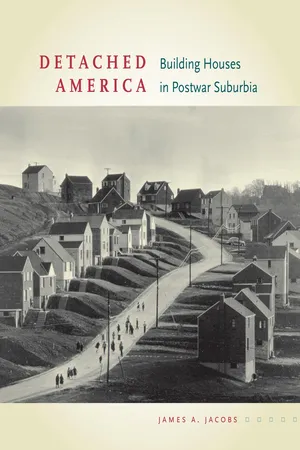
- 272 pages
- English
- ePUB (mobile friendly)
- Available on iOS & Android
About This Book
During the quarter century between 1945 and 1970, Americans crafted a new manner of living that shaped and reshaped how residential builders designed and marketed millions of detached single-family suburban houses. The modest two- and three-bedroom houses built immediately following the war gave way to larger and more sophisticated houses shaped by casual living, which stressed a family's easy sociability and material comfort and were a major element in the cohesion of a greatly expanded middle class. These dwellings became the basic building blocks of explosive suburban growth during the postwar period, luring families to the metropolitan periphery from both crowded urban centers and the rural hinterlands.
Detached America is the first book with a national scope to explore the design and marketing of postwar houses. James A. Jacobs shows how these houses physically document national trends in domestic space and record a remarkably uniform spatial evolution that can be traced throughout the country. Favorable government policies, along with such widely available print media as trade journals, home design magazines, and newspapers, permitted builders to establish a strong national presence and to make a more standardized product available to prospective buyers everywhere. This vast and long-lived collaboration between government and business—fueled by millions of homeowners—established the financial mechanisms, consumer framework, domestic ideologies, and architectural precedents that permanently altered the geographic and demographic landscape of the nation.
Frequently asked questions
Information
Table of contents
- Cover Page
- Title Page
- Copyright
- Contents
- Acknowledgments
- Introduction
- One: The Housing Industry Reinvented
- Two: The Imagined Consumer
- Three: Livability in the Minimum House
- Four: Casual Living
- Five: The Zoned House
- Epilogue
- Notes
- Bibliography
- Index